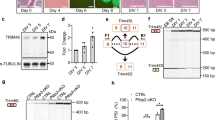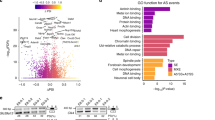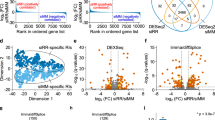Abstract
The endocytic adaptor protein Numb has a major role in development as an intrinsic regulator of cell fate determination and inhibitor of the Notch signaling pathway. In vertebrates, four protein isoforms of Numb are produced through alternative splicing (AS) of two cassette exons (exons 3 and 9). AS of coding exon 9 (E9) produces E9-included (p72/p71) and -excluded (p66/p65) protein products. Expression of Numb isoforms is developmentally regulated and E9-included products are expressed in progenitors, whereas E9-excluded isoforms are dominantly expressed in differentiated cells. Analyses of AS events in multiple cancers previously identified a switch in Numb transcript and protein expression from the E9-excluded to the E9-included isoform, suggesting that misregulation of the mechanisms that control E9 inclusion may have a role in tumorigenesis. Here we identify splicing factors ASF/SF2 and PTBP1 as regulators of E9 splicing and show that activation of the mitogen-activated protein kinase/extracellular signal-regulated kinase pathway promotes E9 inclusion in cancer cells. Our evidence supports a mechanism by which Numb AS is regulated in response to oncogenic signaling pathways, and contributes to activation of downstream pathways to promote tumorigenesis.
This is a preview of subscription content, access via your institution
Access options
Subscribe to this journal
Receive 50 print issues and online access
$259.00 per year
only $5.18 per issue
Buy this article
- Purchase on Springer Link
- Instant access to full article PDF
Prices may be subject to local taxes which are calculated during checkout









Similar content being viewed by others
References
Zhong W, Jiang MM, Schonemann MD, Meneses JJ, Pedersen RA, Jan LY et al. Mouse numb is an essential gene involved in cortical neurogenesis. Proc Natl Acad Sci USA 2000; 97: 6844–6849.
Zilian O, Saner C, Hagedorn L, Lee HY, Säuberli E, Suter U et al. Multiple roles of mouse Numb in tuning developmental cell fates. Curr Biol 2001; 11: 494–501.
Uemura T, Shepherd S, Ackerman L, Jan LY, Jan YN . numb, a gene required in determination of cell fate during sensory organ formation in Drosophila embryos. Cell 1989; 58: 349–360.
Rhyu MS, Jan LY, Jan YN . Asymmetric distribution of numb protein during division of the sensory organ precursor cell confers distinct fates to daughter cells. Cell 1994; 76: 477–491.
Sestan N, Artavanis-Tsakonas S, Rakic P . Contact-dependent inhibition of cortical neurite growth mediated by notch signaling. Science 1999; 286: 741–746.
McGill MA, McGlade CJ . Mammalian numb proteins promote Notch1 receptor ubiquitination and degradation of the Notch1 intracellular domain. J Biol Chem 2003; 278: 23196–23203.
French MB, Koch U, Shaye RE, McGill MA, Dho SE, Guidos CJ et al. Transgenic expression of numb inhibits notch signaling in immature thymocytes but does not alter T cell fate specification. J Immun 2002; 168: 3173–3180.
Berezovska O, McLean P, Knowles R, Frosh M, Lu FM, Lux SE et al. Notch1 inhibits neurite outgrowth in postmitotic primary neurons. Neuroscience 1999; 93: 433–439.
McGill MA, Dho SE, Weinmaster G, McGlade CJ . Numb regulates post-endocytic trafficking and degradation of Notch1. J Biol Chem 2009; 284: 26427–26438.
Sato K, Watanabe T, Wang S, Kakeno M, Matsuzawa K, Matsui T et al. Numb controls E-cadherin endocytosis through p120 catenin with aPKC. Mol Biol Cell 2011; 22: 3103–3119.
Nishimura T, Kaibuchi K . Numb controls integrin endocytosis for directional cell migration with aPKC and PAR-3. Dev Cell 2007; 13: 15–28.
Rašin M-R, Gazula V-R, Breunig JJ, Kwan KY, Johnson MB, Liu-Chen S et al. Numb and Numbl are required for maintenance of cadherin-based adhesion and polarity of neural progenitors. Nat Neurosci 2007; 10: 819–827.
Santolini E, Puri C, Salcini AE, Gagliani MC, Pelicci PG, Tacchetti C et al. Numb is an endocytic protein. J Cell Biol 2000; 151: 1345–1352.
Dho SE, Trejo J, Siderovski DP, McGlade CJ . Dynamic regulation of mammalian Numb by G protein-coupled receptors and protein kinase C activation: structural determinants of Numb association with the cortical membrane. Mol Biol cell 2006; 17: 4142–4155.
Karaczyn A, Bani-Yaghoub M, Tremblay R, Kubu C, Cowling R, Adams TL et al. Two novel human NUMB isoforms provide a potential link between development and cancer. Neural Dev 2010; 5: 31.
Verdi JM, Schmandt R, Bashirullah A, Jacob S, Salvino R, Craig CG et al. Mammalian NUMB is an evolutionarily conserved signaling adapter protein that specifies cell fate. Curr Biol 1996; 6: 1134–1145.
Verdi JM, Bashirullah A, Goldhawk DE, Kubu CJ, Jamali M, Meakin SO et al. Distinct human NUMB isoforms regulate differentiation vs. proliferation in the neuronal lineage. Proc Natl Acad Sci USA 1999; 96: 10472–10476.
Dho SE, French MB, Woods SA, McGlade CJ . Characterization of four mammalian Numb protein isoforms. J Biol Chem 1999; 274: 33097–33104.
Nieber F, Hedderich M, Jahn O, Pieler T, Henningfeld KA . NumbL is essential for Xenopus primary neurogenesis. BMC Dev Biol 2013; 13: 36.
Reugels AM, Boggetti B, Scheer N, Campos-Ortega JA . Asymmetric localization of Numb:EGFP in dividing neuroepithelial cells during neurulation in Danio rerio. Dev Dyn 2006; 235: 934–948.
Revil T, Gaffney D, Dias C, Majewski J, Jerome-Majewska LA . Alternative splicing is frequent during early embryonic development in mouse. BMC Genomics 2010; 11: 399.
Dooley CM, James J, McGlade CJ, Ahmad I . Involvement of numb in vertebrate retinal development: evidence for multiple roles of numb in neural differentiation and maturation. J Neurobiol 2003; 54: 313–325.
Yoshida T, Tokunaga A, Nakao K, Okano H . Distinct expression patterns of splicing isoforms of mNumb in the endocrine lineage of developing pancreas. Differentiation 2003; 71: 486–495.
Bani-Yaghoub M, Kubu CJ, Cowling R, Rochira J, Nikopoulos GN, Bellum S et al. A switch in numb isoforms is a critical step in cortical development. Dev Dyn 2007; 236: 696–705.
Toriya M, Tokunaga A, Sawamoto K, Nakao K, Okano H . Distinct functions of human numb isoforms revealed by misexpression in the neural stem cell lineage in the Drosophila larval brain. Dev Neurosci 2006; 28: 142–155.
Pece S, Serresi M, Santolini E, Capra M, Hulleman E, Galimberti V et al. Loss of negative regulation by Numb over Notch is relevant to human breast carcinogenesis. J Cell Biol 2004; 167: 215–221.
Stylianou S, Clarke RB, Brennan K . Aberrant activation of notch signaling in human breast cancer. Cancer Res 2006; 66: 1517–1525.
Westhoff B, Colaluca IN, D'Ario G, Donzelli M, Tosoni D, Volorio S et al. Alterations of the Notch pathway in lung cancer. Proc Natl Acad Sci USA 2009; 106: 22293–22298.
Maraver A, Fernandez-Marcos PJ, Herranz D, Cañamero M, Muñoz-Martin M, Gómez-López G et al. Therapeutic effect of γ-secretase inhibition in KrasG12V-driven non-small cell lung carcinoma by derepression of DUSP1 and inhibition of ERK. Cancer Cell 2012; 22: 222–234.
Bechara EG, Sebestyén E, Bernardis I, Eyras E, Valcárcel J . RBM5, 6, and 10 differentially regulate NUMB alternative splicing to control cancer cell proliferation. Mol Cell 2013; 52: 720–733.
Misquitta-Ali CM, Cheng E, O'Hanlon D, Liu N, McGlade CJ, Tsao MS et al. Global profiling and molecular characterization of alternative splicing events misregulated in lung cancer. Mol Cell Biol 2011; 31: 138–150.
Zong F-Y, Fu X, Wei W-J, Luo Y-G, Heiner M, Cao L-J et al. The RNA-binding protein QK1 suppresses cancer-associated aberrant splicing. PLoS Genet 2014; 10: e1004289.
Langer W, Sohler F, Leder G, Beckmann G, Seidel H, Gröne J et al. Exon array analysis using re-defined probe sets results in reliable identification of alternatively spliced genes in non-small cell lung cancer. BMC Genomics 2010; 11: 676.
Zhang S, Liu Y, Liu Z, Zhang C, Cao H, Ye Y et al. Transcriptome profiling of a multiple recurrent muscle-invasive urothelial carcinoma of the bladder by deep sequencing. PLoS One 2014; 9: e91466.
Paz I, Akerman M, Dror I, Kosti I, Mandel-Gutfreund Y . SFmap: a web server for motif analysis and prediction of splicing factor binding sites. Nucleic Acids Res 2010; 38: W281–W285.
Stickeler E, Fraser SD, Honig A, Chen AL, Berget SM, Cooper TA . The RNA binding protein YB-1 binds A/C-rich exon enhancers and stimulates splicing of the CD44 alternative exon v4. EMBO J 2001; 20: 3821–3830.
Izaguirre DI, Zhu W, Hai T, Cheung HC, Krahe R, Cote GJ . PTBP1-dependent regulation of USP5 alternative RNA splicing plays a role in glioblastoma tumorigenesis. Mol Carcinog 2012; 51: 895–906.
Christofk HR, Vander Heiden MG, Harris MH, Ramanathan A, Gerszten RE, Wei R et al. The M2 splice isoform of pyruvate kinase is important for cancer metabolism and tumour growth. Nature 2008; 452: 230–233.
Karni R, de Stanchina E, Lowe SW, Sinha R, Mu D, Krainer AR . The gene encoding the splicing factor SF2/ASF is a proto-oncogene. Nat Struct Mol Biol 2007; 14: 185–193.
Teplova M, Patel DJ . Structural insights into RNA recognition by the alternative-splicing regulator muscleblind-like MBNL1. Nat Struct Mol Biol 2008; 15: 1343–1351.
Ho TH, Charlet BN, Poulos MG, Singh G, Swanson MS, Cooper TA . Muscleblind proteins regulate alternative splicing. EMBO J 2004; 23: 3103–3112.
Zhang C, Frias MA, Mele A, Ruggiu M, Eom T, Marney CB et al. Integrative modeling defines the Nova splicing-regulatory network and its combinatorial controls. Science 2010; 329: 439–443.
Cheung HC, Hai T, Zhu W, Baggerly Ka, Tsavachidis S, Krahe R et al. Splicing factors PTBP1 and PTBP2 promote proliferation and migration of glioma cell lines. Brain 2009; 132: 2277–2288.
Brognard J, Clark AS, Ni Y, Dennis PA . Akt/Protein Kinase B is constitutively active in non-small cell lung cancer and promotes cellular survival and resistance to chemotherapy and radiation. Cancer Res 2001; 61: 3986–3997.
Roberts PJ, Der CJ . Targeting the Raf-MEK-ERK mitogen-activated protein kinase cascade for the treatment of cancer. Oncogene 2007; 26: 3291–3310.
Ohori M, Kinoshita T, Okubo M, Sato K, Yamazaki A, Arakawa H et al. Identification of a selective ERK inhibitor and structural determination of the inhibitor-ERK2 complex. Biochem Biophys Res Commun 2005; 336: 357–363.
Kim KK, Nam J, Mukouyama Y-S, Kawamoto S . Rbfox3-regulated alternative splicing of Numb promotes neuronal differentiation during development. J Cell Biol 2013; 200: 443–458.
Makeyev EV, Zhang J, Carrasco MA, Maniatis T . The MicroRNA miR-124 promotes neuronal differentiation by triggering brain-specific alternative pre-mRNA splicing. Mol Cell 2007; 27: 435–448.
He X, Arslan AD, Ho T-T, Yuan C, Stampfer MR, Beck WT . Involvement of polypyrimidine tract-binding protein (PTBP1) in maintaining breast cancer cell growth and malignant properties. Oncogenesis 2014; 3: e84.
He X, Pool M, Darcy KM, Lim SB, Auersperg N, Coon JS et al. Knockdown of polypyrimidine tract-binding protein suppresses ovarian tumor cell growth and invasiveness in vitro. Oncogene 2007; 26: 4961–4968.
McCutcheon IE, Hentschel SJ, Fuller GN, Jin W, Cote GJ . Expression of the splicing regulator polypyrimidine tract-binding protein in normal and neoplastic brain. Neuro-Oncology 2004; 6: 9–14.
Cheung HC, Corley LJ, Fuller GN, McCutcheon IE, Cote GJ . Polypyrimidine tract binding protein and Notch1 are independently re-expressed in glioma. Mod Pathol 2006; 19: 1034–1041.
Das S, Anczuków O, Akerman M, Krainer AR . Oncogenic splicing factor SRSF1 is a critical transcriptional target of MYC. Cell Rep 2012; 1: 110–117.
Guo R, Li Y, Ning J, Sun D, Lin L, Liu X . HnRNP A1/A2 and SF2/ASF regulate alternative splicing of interferon regulatory factor-3 and affect immunomodulatory functions in human non-small cell lung cancer cells. PLoS One 2013; 8: e62729.
Bray SJ . Notch signalling: a simple pathway becomes complex. Nat Rev Mol Cell Biol 2006; 7: 678–689.
Guo S, Liu M, Gonzalez-Perez R . Role of Notch and its oncogenic signaling crosstalk in breast cancer. Biochim Biophys Acta 2011; 1815: 197–213.
Al-Hussaini H, Subramanyam D, Reedijk M, Sridhar SS . Notch signaling pathway as a therapeutic target in breast cancer. Mol Cancer Ther 2011; 10: 9–15.
Izrailit J, Berman HK, Datti A, Wrana JL, Reedijk M . High throughput kinase inhibitor screens reveal TRB3 and MAPK-ERK/TGFβ pathways as fundamental Notch regulators in breast cancer. Proc Natl Acad Sci USA 2013; 110: 1714–1719.
Blissenbach M, Grewe B, Hoffmann B, Brandt S, Uberla K . Nuclear RNA export and packaging functions of HIV-1 Rev revisited. J Virol 2010; 84: 6598–6604.
Livak KJ, Schmittgen TD . Analysis of relative gene expression data using real-time quantitative PCR and the 2(-Delta Delta C(T)) method. Methods 2001; 25: 402–408.
Acknowledgements
We thank J Woodgett (University of Toronto) for activated MEK and MEKK, V Stambolic (University of Toronto) for Akt constructs, G Zadeh (University of Toronto) for activated RAS, M Moran (University of Toronto) for A549 cells, A Huang (University of Toronto) for YBX1 plasmid, B Blencowe (University of Toronto) for ExonTrap pet01 plasmid, SPARC BioCentre (Hospital for Sick Children, Toronto) for cDNAs and S Dho for comments on the manuscript. This work was supported by an operating grant to CJM from the Canadian Institutes of Health Research (MOP-106507). YZ is supported by a RESTRACOMP studentship from the Garron Family Cancer Centre and Sickkids Research Institute.
Author information
Authors and Affiliations
Corresponding author
Ethics declarations
Competing interests
The authors declare no conflict of interest.
Additional information
Supplementary Information accompanies this paper on the Oncogene website
Rights and permissions
About this article
Cite this article
Rajendran, D., Zhang, Y., Berry, D. et al. Regulation of Numb isoform expression by activated ERK signaling. Oncogene 35, 5202–5213 (2016). https://doi.org/10.1038/onc.2016.69
Received:
Revised:
Accepted:
Published:
Issue Date:
DOI: https://doi.org/10.1038/onc.2016.69



